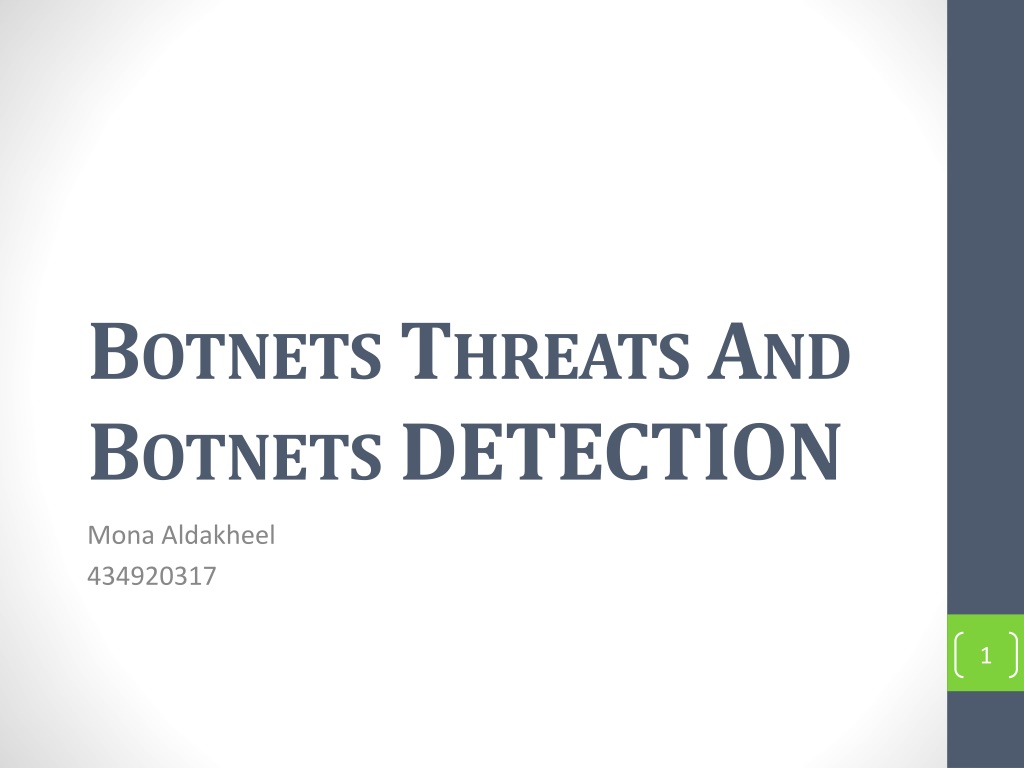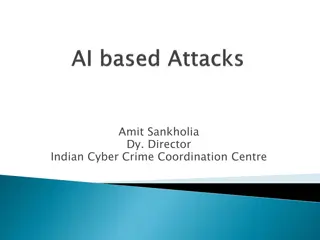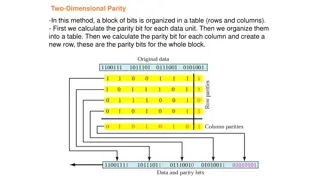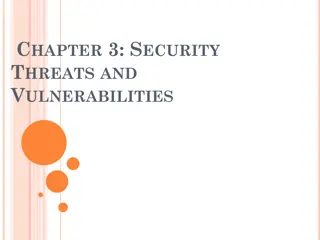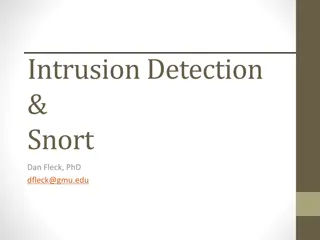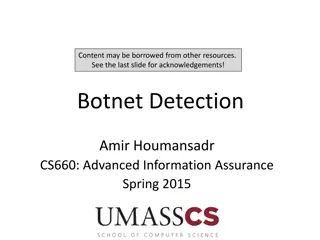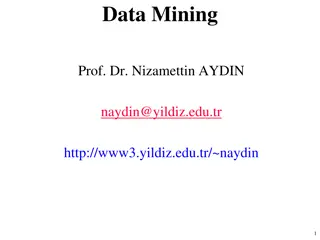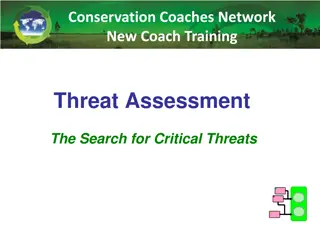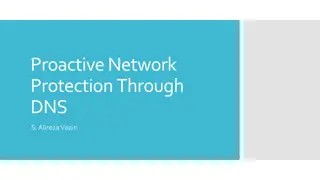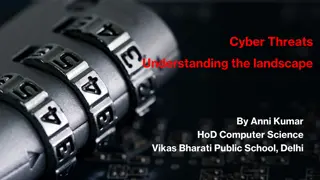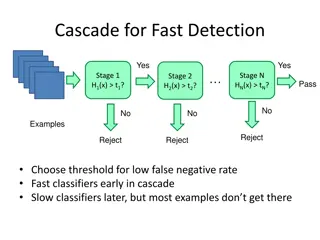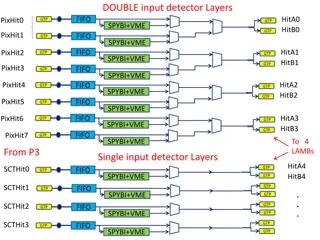Understanding Botnets: Threats, Detection, and Control Techniques
Explore the world of botnets, learn about the creation, propagation, and command & control techniques used by malicious actors. Discover the security threats posed by botnets and methods to detect and mitigate them effectively. Images and detailed explanations provide insights into handling bot-related challenges.
Download Presentation

Please find below an Image/Link to download the presentation.
The content on the website is provided AS IS for your information and personal use only. It may not be sold, licensed, or shared on other websites without obtaining consent from the author. Download presentation by click this link. If you encounter any issues during the download, it is possible that the publisher has removed the file from their server.
E N D
Presentation Transcript
BOTNETSTHREATSAND BOTNETSDETECTION Mona Aldakheel 434920317 1
Outline BOTS AND BOTNETS BOTNET CREATION AND PROPOGATION BOTNET COMMAND AND CONTROL (C&C) TECHNIQUES Rallying Mechanisms Communication Protocols SECURITY THREATS FROM BOTNET BOTNET DETECTION 2
BOTS AND BOTNETS The term Bot is derived from the word Robot Bots are designed to perform some predefined functions in automated way. Botnet is a network of infected machines which are under the control of a human operator commonly known as botmaster. 3
Example illustrates how a botnet is created and used to sendspam. 4
BOTNET CREATION AND PROPOGATION Methods to create bot: write code extend or customize an existing bot. Methods to propagate: exploit vulnerabilities sending out email messages setting up Web sites 6
BOTNET COMMAND AND CONTROL (C&C) TECHNIQUES Centralized Command & Control (C&C) Technique P2P Command & Control (C&C) Technique Random Command & Control (C&C) Technique 7
Centralized Command & Control (C&C) Technique 8
Centralized Command & Control (C&C) Technique Advantages of using centralized C&C techniques A great amount of resources are available online to create a C&C based botnet Allows controlling of as many bots as possible and thus maximizes the profit of the botmaster. Small message latency Disadvantages of using centralized C&C techniques Easy to shutdown. 9
P2P Command & Control (C&C) Technique 10
P2P Command & Control (C&C) Technique Advantages of using P2P Command & Control (C&C) Technique Harder to locate, shutdown, monitor, and hijack Propagation latency is lacking in P2P systems Disadvantages of using P2P Command & Control (C&C) Technique Hard to launch large scale attacks 11
Random Command & Control (C&C) Technique 12
Random Command & Control (C&C) Technique Advantage: Easy implementation Resilient to discovery and destruction Disadvantage Hard to launch large scale attacks Propagation latency is very high. 13
Rallying Mechanisms Rallying mechanisms used for: Discover new bots Rally them under their botmasters. Rallying Mechanisms: Hard-coded IP Address Dynamic DNS Domain Name 14
Hard-coded IP Address A common method used to rally new bots works like this: A bot includes hard-coded C&C server IP addressesin its binary. When the bot initially infects a computer, the computer will connect back to the C&C server using the hard-coded server IP address. 15
Drawbacks of Hard-coded IP Address The problem with using hard-coded IP addresses is that The C&C server can be easily detected The communication channel can be easily blocked. 16
Dynamic DNS Domain Name The bots today often include hard-coded domain names, assigned by dynamical DNS providers. 17
Benefit of Dynamic DNS Domain Name if a C&C server is shutdown by authorities, the botmaster can easily resume his/her control by creating a new C&C server. 18
Communication Protocols IRC Protocol HTTP Protocol P2P Protocol 19
SECURITY THREATS FROM BOTNET Distributed Denial of Services (DDoS) Spamming Phishing and Identity Theft Click Fraud Hosting illegal material and disseminating malicious code 20
Distributed Denial of Services (DDoS) Distributed Denial of Services (DDoS) attack is direct attempt of attackers to prevent legitimate users from using a specific service using multiple compromised systems. Two main variants of DDoS attacks Bandwidth depletion (Flooding and reflection attacks ) Resource depletion. 21
Spamming Spamming is any message or posting, regardless of its content, that is sent to multiple recipients who have not specifically requested the message 22
Phishing and Identity Theft Phishing and Identity Theft is a fraudulent activity defined as the creation of a replica of an existing Web page or other online resource to deceive a user into submitting personal, financial, or password data 23
Click Fraud its fake clicks to maximize the revenue of certain users from the ads they publish on their websites. 24
Hosting illegal material and disseminating malicious code Illegal material can be stored as a dynamic repository on a bot compromised computer by the botmaster. 25
BOTNET DETECTION Honeypot passive network traffic monitoring and analysis. Signature-based Detection Anomaly-based detection techniques DNS-based detection techniques Mining-based Detection 26
Signature-basedDetection Useful way for botnet detection based on Knowledge of useful signatures and behavior of existing botnets. For example, Snort 27
Anomaly-based detection techniques Attempt to detect botnets based on several network traffic anomalies such as high network latency. 28
DNS-based detection techniques Detect botnets based on several DNS traffic anomalies 29
Mining-based Detection One of effective technique for botnet detection to identifybotnet C&C traffic. Several data mining techniques including machine learning, classification, and clustering can be used efficiently to detectbotnet C&C traffic. 30
Thanks 31
